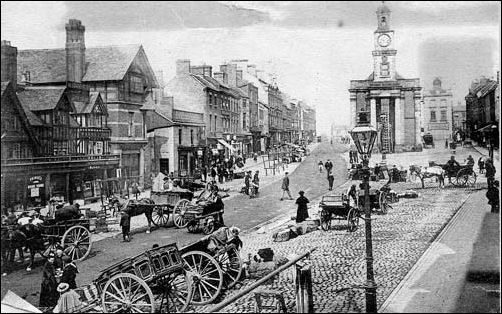 |
| Photo: Jo Taylor. Young enters North Staffs, leaving Cheshire with a dig about their rubbish horses. |
Aside from attempting (badly) to decipher the letters of Coleridges writing in various degrees of sobriety, I'm doing a few tasks for the Jerwood Centre team. My first task this morning involved delving in to Arthur Young's four-volume account, A Six Months Tour Through the North of England (1771). The account begins near Hull, and follows Young on his journey south, along the way taking in Newcastle-on-Tyne, Yorkshire, the Lake District, Liverpool, Lancashire and Cheshire, among other places. Young toured the country, visiting local landmarks and, essentially, comparing the different methods of cabbage-growing. Young discusses the soil quality of the areas he visits, examines the local industry (including the wages of the workforce), and includes diagrams of the farm machinery in use.
Fascinating though I undoubtedly find the growing habits of different varieties of 'ternips', it wasn't the agricultural information that caught my eye. No, what really got my attention was scan-reading a page, only to see the phrase "I had the pleasure of viewing... Burslem". Naturally, I had then to read on.
 |
| Top photo: High Street, Newcastle, 1895. http://www.thepotteries.org/tour/023.htm Bottom Photo: Jo Taylor. All praise Wedgwood (and, specifically, his canny business partner) |
Young enters into a detailed description of the various manufactories around "Newcastle-under-line". He credits the famous Mr. Wedgwood with establishing a thriving local economy; all other potters, he says, are "little better than mere imitators". Mr. Wedgwood has, it seems,
lately entered into partnership with a man of sense and spirit, who will have taste enough to continue in the investing plan, and not suffer, in case of accidents, the manufactories to decline.How this relates to the Potteries now, I will leave for others to discuss; needless to say, perhaps, that a similar man "of sense and spirit" would find plenty to do nearly two and a half centuries later! Regardless, Young's congratulation of North Staffordshire generally, and the Wedgwood potteries particularly, serve as a quaint reminder of the hope invested in the Stoke-on-Trent area at the beginning of the Industrial Revolution, when the Burslem potteries were on the cutting edge of industrialisation and the technology that went with it.
 |
| Photo: Jo Taylor. Newcastle: home of hats. |
 |
| Photo: Jo Taylor. Young considers local agricultural practices. Cows & potatoes good. Beans bad. |
Nevertheless, Young presents an image of North Staffordshire that fits in well with his idyllicised descriptions of the more northerly parts of England. Certainly, it is an optimistic representation to the point of outright falsehood; although we may find traces of social criticism, Young deliberately overlooks the poor working and living conditions of the "Poor man". Regardless, it's a good reminder of the things Stoke still does have to offer. We're told that Hollywood directors are being invited to Stoke; maybe they should follow Young's footsteps.
 |
| Photo: Jo Taylor. Young heads on towards Rugeley |

No comments:
Post a Comment